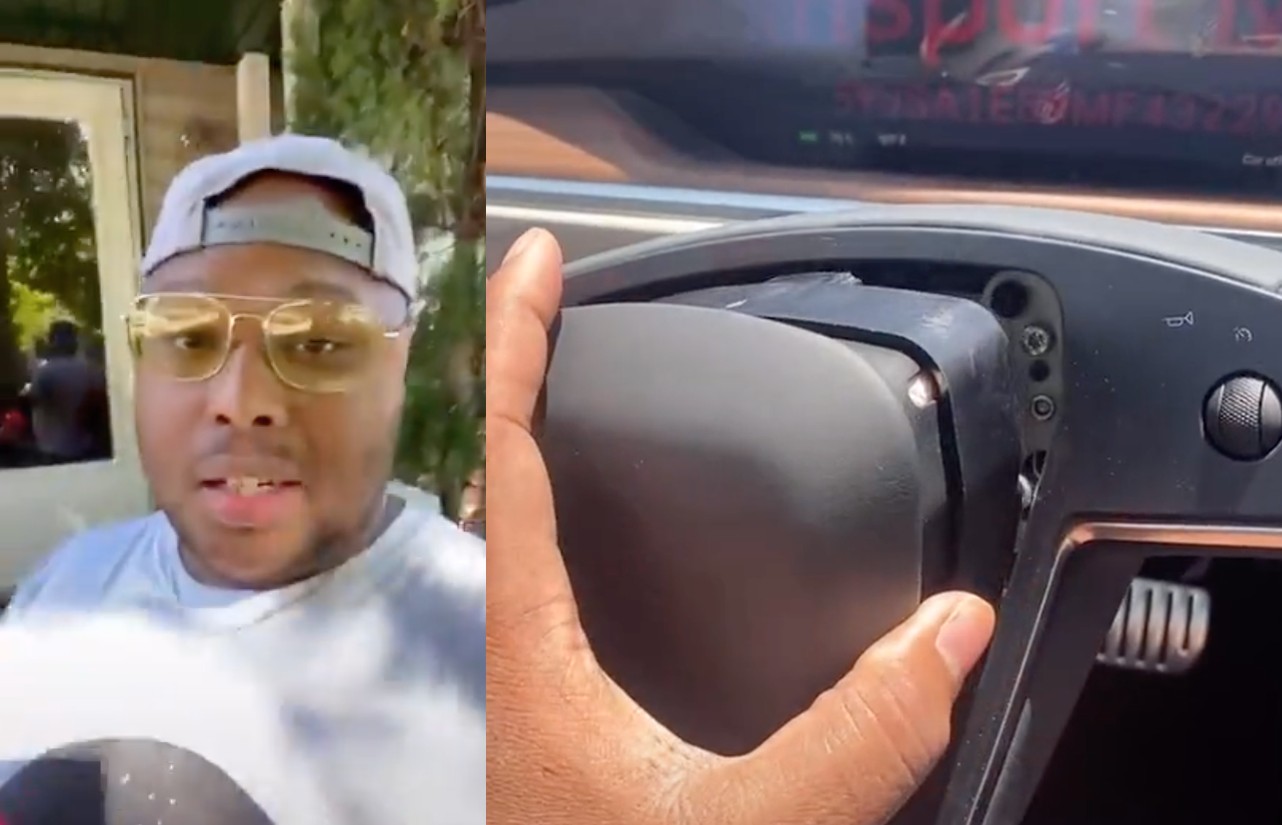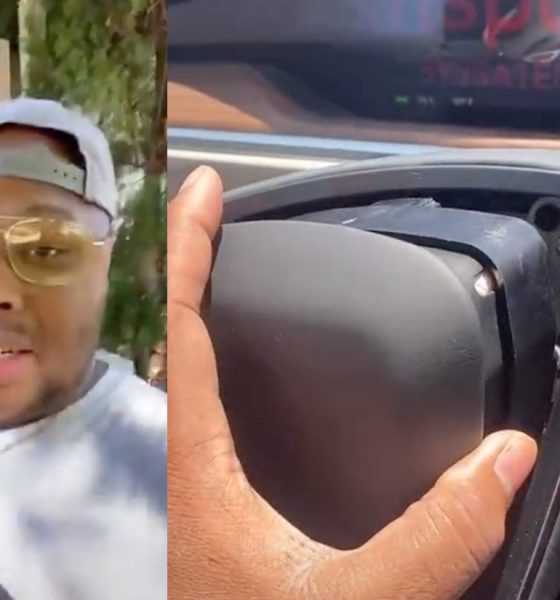

News
TikTok creator apologizes to Tesla, admits that “defective” Model S in viral video was not his
TikTok creator Ricco Kimborough has come clean about a viral Tesla post where he supposedly took delivery of a Model S with an airbag unit that fell apart in his hands. The social media enthusiast posted his apology on TikTok, admitting that the vehicle in the video was not really his and that he simply sat in an unlocked car at a Tesla delivery center.
“This video is for Elon Musk. I love your product, sir, I do. I love your product. I had no idea, and I’m sorry from the bottom of my heart. I had no idea that I was not supposed to get into that vehicle because it was not locked at all. I just want to say, I apologize… This video went viral and I got a call from the actual police department saying that they don’t want me on their property… So this message is to Elon Musk… I’m sorry and I’m actually purchasing a Tesla. Got one on order,” Kimborough said.
Guy who created fake viral TikTok video apologies to @elonmusk, admits he just sat in a car at the delivery center that was not his pic.twitter.com/lpVQNyPK4U
— Whole Mars Catalog (@WholeMarsBlog) June 28, 2021
Kimborough’s viral video became a rallying cry of sorts among the anti-Tesla crowd, especially considering his “reactions” to his vehicles’ alleged defect. In the video, the TikTok creator stated that the vehicle was some “cheap baloney” and that such defects were unacceptable. Later videos even showed Kimborough allegedly coming to a Tesla location to complain about “his” Model S. That being said, the TikTok creator’s viral video did have some red flags from the get-go.
Immediately noticeable from the viral video was that the Model S “Plaid” that Kimborough allegedly took delivery of still had some of the protective wraps Tesla uses when transporting its cars. The vehicle was also in Transport Mode, which suggests that it was not in any way ready to be handed over to a customer. Contrary to the TikTok creator’s Model S Plaid claims, the vehicle was also a Model S Long Range, which was not yet being delivered to customers then.
@riccokimbrough##tesla ##elonmusk♬ original sound – ✅ Ricco kimbrough♋️
So what of the substantial media coverage of Kimborough’s viral video, such as this, this, this, this, and this now that the video has been debunked by its creator? Well, that’s just the thing with these false pieces. Some outlets such as motoring media outlet Jalopnik have posted corrections to their initial coverage. But others, not so much. This, unfortunately, will likely result in a great number of people still believing that the TikTok creator’s initial video was real, despite the fact that it’s not.
As previously explained to Teslarati by Emma Frances Bloomfield (PhD), currently an Assistant Professor of Communication Studies at the University of Nevada, Las Vegas, correcting misinformation requires halting the repetition of false information. “To address misinformation, people can create more complete stories that replace the incorrect one, provide trustworthy authority figures to deliver the message, and not repeat the false information when making the correction. We say, “correct early and correct often” to try and get ahead of the temporal advantage misinformation has and to counter the repetition of the false information,” she stated.
Considering the usual narratives surrounding Tesla, countering this proven false claim would definitely be challenging.
Do you have anything to share with the Teslarati Team? We’d love to hear from you, email us at tips@teslarati.com.

News
Tesla FSD fleet is nearing 7 billion total miles, including 2.5 billion city miles
As can be seen on Tesla’s official FSD webpage, vehicles equipped with the system have now navigated over 6.99 billion miles.

Tesla’s Full Self-Driving (Supervised) fleet is closing in on almost 7 billion total miles driven, as per data posted by the company on its official FSD webpage.
These figures hint at the massive scale of data fueling Tesla’s rapid FSD improvements, which have been quite notable as of late.
FSD mileage milestones
As can be seen on Tesla’s official FSD webpage, vehicles equipped with the system have now navigated over 6.99 billion miles. Tesla owner and avid FSD tester Whole Mars Catalog also shared a screenshot indicating that from the nearly 7 billion miles traveled by the FSD fleet, more than 2.5 billion miles were driven inside cities.
City miles are particularly valuable for complex urban scenarios like unprotected turns, pedestrian interactions, and traffic lights. This is also the difference-maker for FSD, as only complex solutions, such as Waymo’s self-driving taxis, operate similarly on inner-city streets. And even then, incidents such as the San Francisco blackouts have proven challenging for sensor-rich vehicles like Waymos.
Tesla’s data edge
Tesla has a number of advantages in the autonomous vehicle sector, one of which is the size of its fleet and the number of vehicles training FSD on real-world roads. Tesla’s nearly 7 billion FSD miles then allow the company to roll out updates that make its vehicles behave like they are being driven by experienced drivers, even if they are operating on their own.
So notable are Tesla’s improvements to FSD that NVIDIA Director of Robotics Jim Fan, after experiencing FSD v14, noted that the system is the first AI that passes what he described as a “Physical Turing Test.”
“Despite knowing exactly how robot learning works, I still find it magical watching the steering wheel turn by itself. First it feels surreal, next it becomes routine. Then, like the smartphone, taking it away actively hurts. This is how humanity gets rewired and glued to god-like technologies,” Fan wrote in a post on X.
News
Tesla starts showing how FSD will change lives in Europe
Local officials tested the system on narrow country roads and were impressed by FSD’s smooth, human-like driving, with some calling the service a game-changer for everyday life in areas that are far from urban centers.

Tesla has launched Europe’s first public shuttle service using Full Self-Driving (Supervised) in the rural Eifelkreis Bitburg-Prüm region of Germany, demonstrating how the technology can restore independence and mobility for people who struggle with limited transport options.
Local officials tested the system on narrow country roads and were impressed by FSD’s smooth, human-like driving, with some calling the service a game-changer for everyday life in areas that are far from urban centers.
Officials see real impact on rural residents
Arzfeld Mayor Johannes Kuhl and District Administrator Andreas Kruppert personally tested the Tesla shuttle service. This allowed them to see just how well FSD navigated winding lanes and rural roads confidently. Kruppert said, “Autonomous driving sounds like science fiction to many, but we simply see here that it works totally well in rural regions too.” Kuhl, for his part, also noted that FSD “feels like a very experienced driver.”
The pilot complements the area’s “Citizen Bus” program, which provides on-demand rides for elderly residents who can no longer drive themselves. Tesla Europe shared a video of a demonstration of the service, highlighting how FSD gives people their freedom back, even in places where public transport is not as prevalent.
What the Ministry for Economic Affairs and Transport says
Rhineland-Palatinate’s Minister Daniela Schmitt supported the project, praising the collaboration that made this “first of its kind in Europe” possible. As per the ministry, the rural rollout for the service shows FSD’s potential beyond major cities, and it delivers tangible benefits like grocery runs, doctor visits, and social connections for isolated residents.
“Reliable and flexible mobility is especially vital in rural areas. With the launch of a shuttle service using self-driving vehicles (FSD supervised) by Tesla in the Eifelkreis Bitburg-Prüm, an innovative pilot project is now getting underway that complements local community bus services. It is the first project of its kind in Europe.
“The result is a real gain for rural mobility: greater accessibility, more flexibility and tangible benefits for everyday life. A strong signal for innovation, cooperation and future-oriented mobility beyond urban centers,” the ministry wrote in a LinkedIn post.
News
Tesla China quietly posts Robotaxi-related job listing
Tesla China is currently seeking a Low Voltage Electrical Engineer to work on circuit board design for the company’s autonomous vehicles.

Tesla has posted a new job listing in Shanghai explicitly tied to its Robotaxi program, fueling speculation that the company is preparing to launch its dedicated autonomous ride-hailing service in China.
As noted in the listing, Tesla China is currently seeking a Low Voltage Electrical Engineer to work on circuit board design for the company’s autonomous vehicles.
Robotaxi-specific role
The listing, which was shared on social media platform X by industry watcher @tslaming, suggested that Tesla China is looking to fill the role urgently. The job listing itself specifically mentions that the person hired for the role will be working on the Low Voltage Hardware team, which would design the circuit boards that would serve as the nervous system of the Robotaxi.
Key tasks for the role, as indicated in the job listing, include collaboration with PCB layout, firmware, mechanical, program management, and validation teams, among other responsibilities. The role is based in Shanghai.
China Robotaxi launch
China represents a massive potential market for robotaxis, with its dense urban centers and supportive policies in select cities. Tesla has limited permission to roll out FSD in the country, though despite this, its vehicles have been hailed as among the best in the market when it comes to autonomous features. So far, at least, it appears that China supports Tesla’s FSD and Robotaxi rollout.
This was hinted at in November, when Tesla brought the Cybercab to the 8th China International Import Expo (CIIE) in Shanghai, marking the first time that the autonomous two-seater was brought to the Asia-Pacific region. The vehicle, despite not having a release date in China, received a significant amount of interest among the event’s attendees.








